Chiffchaffs wintering in Kuwait : which subspecies? |
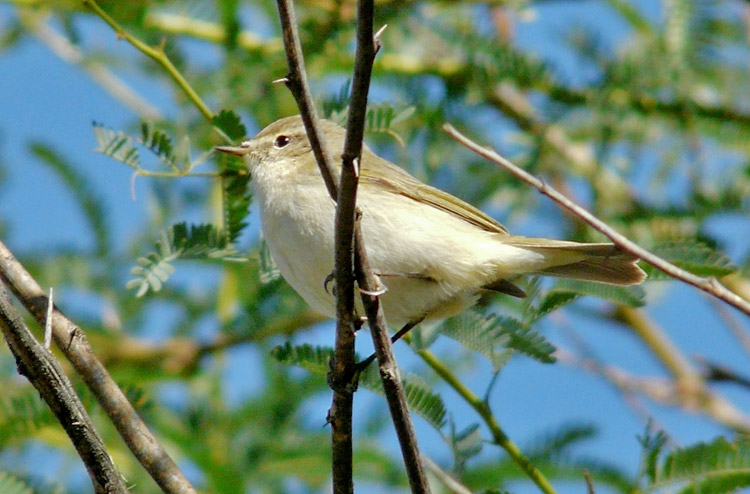
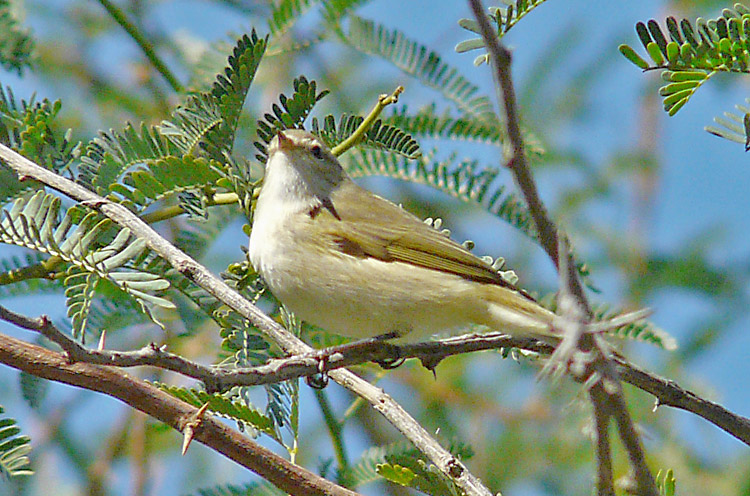
Chiffchaff, Al Abraq, Kuwait, December 2nd 2013
Certain Chiffchaffs wintering in Kuwait have enigmatic plumage and calls. The crown and mantle are olive-brown while the underparts are rather pale, with relatively limited yellow streaking. However, there are evident olive fringes to the flight-feathers. The plumage lacks the rusty-buff or 'tan' suffusions typical of Siberian Chiffchaff. Their call is short and can sound similar to tristis to the human ear. Indeed, some visiting birders have equated this call with tristis. However, although starting on an even pitch, as it progresses it rises and then falls, creating a subtle 'sweeoo' sound to the end of the call. This 'terminal arch' creates a distinctive shape in a sonogram (see below).
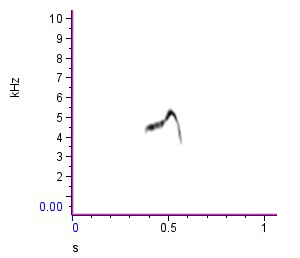
Fig. 1. Call of Chiffchaff at Jahra, Kuwait, November 2013
The call can be heard here ►. Siberian Chiffchaff calls vary to an extent and include at times a shallowly but evenly arched variant. The 'inflection' in the Kuwaiti chiffchaffs' call is much more pronounced and is positioned towards the end of the call. Within c. 0.1s it rises and falls approximately equally either side of the pitch of the opening section. Hence the inflection is not readily perceived by the human ear and confusion with a tristis call can result. The subspecies involved in these Kuwaiti Chiffchaffs is subject to a great deal of speculation. Discussing Chiffchaffs he had observed in Jordan, Dubois (2010) suggested that they were probably attributable to brevirostris and that their call was tristis-like but 'sometimes with a falling terminal 'e', which rendered a more plaintive call'. He further suggested that birds of this type might reach Kuwait. Other suggestions for the Kuwaiti birds have included menzbieri, though the basis for this appears undocumented.
The 'terminal arch' shape does not match any of the sonograms of Chiffchaff races published by Helbig et al. (1996) and repeated by Clement et al. (1998), although the first call illustrated in section 'k' and attributed to caucasicus in Helbig et al. closely matches the flat opening and the rising pitch at the midway point. However, apparently, it lacks the concluding downward tail (unless this has been lost in the recording or subsequent processing of the sonogram). The shape of the Kuwaiti calls and that of the first call in Helbig et al's sonogram 'k' are very different from the straight ('flat') call attributed to caucasicus in the second profile in Helbig et al's sonogram 'k'. However, that call was recorded at Alamdeh in northern Iran, a region where the breeding form has now been inferred to be menzbieri by the genetic studies of Raković et al. (2019). These genetic studies have brought into question the precise distributions of caucasicus and menzbieri. Traditionally regarded as confined to a relatively small region based around Kopet Dagh, the range of menzbieri is now inferred to extend from Kopet Dagh across the entire Hyrcanian Forest of northern Iran and into southern Armenia, with a region of overlap with caucasicus around the Lesser Caucasus. Thus, published calls historically attributed to caucasicus now require require re-examination and consideration of the exact location of the recordings
The typical call of Chiffchaffs breeding in northern Iran has a shallow 'terminal arch' (for details and further discussion see Chiffchaffs in Iran and Armenia). The arch in Iranian recordings tends to be much shallower than in the Kuwait recordings but, confusingly, both 'terminal arch' and 'flat' calls have been recorded from a similar area of N. Iran, within a region where the breeding form is now deemed to be menzbieri.
In Azerbaijan, on March 19th 2012, Timo Janhonen recorded Chiffchaffs with a call comparable to those in Kuwait, with an evenly pitched ('flat') opening followed by a prominent 'terminal arch' (in sonograms). The recording is available <here>.and photos <here> on Tarsiger. The breeding form in Azerbaijan is deemed to be caucasicus (though note the comment above re the genetic findings of Raković et al. 2019) but the early date does not confirm birds established on territory. There were several such birds but Timo Janhonen states (in lit.) that they were in lowland shrubberies and meadows by the Caspian Sea (rather than the forest) and, consequently, it is impossible to know whether they were arriving near their breeding grounds or were migrants en route farther afield. Timo also noted a very similar call <here> on xeno-canto (xc212252), recorded in Azerbaijan in January 2015 by Steve Klasan. Confusingly, another series of calls with a distinctly shallower 'terminal arch' - closer to the sonograms of birds in northern Iran - was recorded by Matthias Bull at Mingecevir in Azerbaijan, on February 1st 2018 (xc411370). Hence, individuals with 'terminal arch' calls apparently winter in the region, while the prominence of the 'terminal arch' either varies individually or more than one subspecies is involved (Fig. 2).
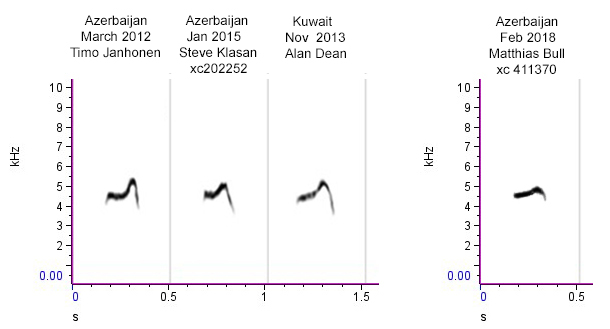
Fig. 2. Left: High 'terminal arch' calls of Chiffchaffs from
: Azerbaijan, March 2012;
Azerbaijan January 2015; Kuwait, November 2013.
Right: Low 'terminal arch' call: from Azerbaijan. February 2018.
Azerbaijan sonograms prepared from recordings by
Timo Janhonen
(Tarsiger), Steve
Klasan (xeno-canto) and Matthias Bull (xeno-canto.)
A profile with a shallow 'terminal arch' is evident in calls recorded by Cedric Mroczko at Alogol in NE Iran and placed on xeno-canto (xc513431). Being on the border with Turkmenistan, this location would be firmly within the breeding range of menzbieri though, as the recordings were made in November, it is again conceivable that another taxon may be involved.
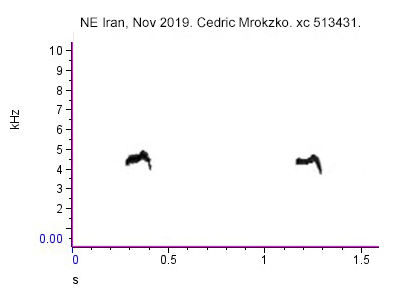
Fig. 3. Calls of Chiffchaff from Alagol, NE Iran, Nov 2019. Sonogram prepared from recording by Cedric Mroczko on xeno-canto.
However, sonograms of calls recorded by Irina Marova at the type locality of menzbieri at Kopet Dagh (again see sonograms in Helbig et al. 1996 and Clement et al. 1998) and sonograms of calls I recorded in the Elborz mountains of northern Iran in April 2017 (all involving Chiffchaffs on territory) all show a shallow 'terminal arch'. These shallower arch calls, from the range now attributed to menzbieri, rise above the straight opening by 0.25 kHz to 0.5 kHz, compared with 0.5 kHz or more in the Kuwait and two of the three Azerbaijan recordings. On xeno-canto, there are recordings of calls made in Turkey and attributed to brevirostris (though not all made in the core breeding season) which show a terminal arch equally as prominent as that in the Kuwait and the higher arch Azerbaijan recordings. This shape is very different from the slightly falling-pitch (downward-sloping) call attributed to brevirostris in Helbig et al. 1996 (repeated in Clement et al. 1998) and also in BWP6. This downward-sloping call attributed to brevirostris is much more similar in profile to the call of lorenzii than to the 'terminal arch' call of brevirostris, though it starts at around 4 kHz to 4.5 kHZ compared with around 5kHz in lorenzii (see sonograms 'i' and 'm' in Helbig et al. (1996 ) and Clement et al. (1998). The 'terminal arch' call and the 'down-sloping' call associated with brevirostris will both sound rather like tristis by ear but they have significantly different profiles in sonograms. Among the xeno-canto recordings from Turkey is a combination file from Daniel Duff which includes call and song from March recordings at Kusadasi, south of Izmir. The call has the slightly falling-pitch form while the song is unequivocally that associated with brevirostris (a multi-spurred profile - see Marova et al. 2021). Compounding the enigma are two xeno-canto recordings from Kemer, Antalya, made by Johan Buckens on successive days in March 2019 (xc513459 and xc513457). The first of these is a well-pronounced 'terminal arch' call while the second is a ’down-sloping’ call. If brevirostris does in fact have both a prominent 'terminal arch' call and a downward-sloping call, what is their functional difference?
In summary, it seems established that menzbieri has a shallow 'terminal arch' call and that the 'terminal arch' calls recorded in Kuwait (and some calls from Turkey attributed to brevirostris) have a more-prominent 'terminal arch' profile. However, whether menzbieri has other calls (see 'Chiffchaffs in Iran and Armenia') requires further research. So too whether the prominence of the 'terminal arch' is a product of individual variation or is a distinction between taxa.
The breeding and non-breeding distributional boundaries of menzbieri, caucasicus and brevirostris require confirmation, as do the range of variation and potential overlap in their calls. To minimise confusion, comprehensive recordings on the breeding grounds (rather than in winter) are a pre-requisite. See further discussion of vocalisations in: 'Chiffchaffs in Iran and Armenia', where selected sonograms published by Helbig et al. and Clement et al. are also reproduced (with permission from British Birds).
Interestingly, in an item on variants among tristis-style calls (https://caluta.fi/Linnut/Phylloscopus/tristis/trcall.html), Antero Lindholm includes a call with a similar shape (the second call in his example 5). (Note that the captions and recordings, although somewhat displaced, are positioned below the corresponding figure). This call was recorded in Oman in November 2002, so may be attributable to a southern Chiffchaff taxon. It would not be surprising if a Chiffchaff taxon occurring in Kuwait also reached Oman.
Acknowledgement
Many thanks to Timo Janhonen for providing recordings and other useful data from Azerbaijan, Antero Lindholm for discussions of the Chiffchaffs found in Georgia and adjoining regions and the sound-recordists who have uploaded recordings to xeno-canto, which provides a public platform for valuable audio data.
References
Clement, P., Helbig A. J & Small, B. 1998. Taxonomy and identification of chiffchaffs in the Western Palearctic. Brit. Birds 91: 361-376.
Cramp, S. (ed.) 1992. The Birds of the Western Palearctic. Vol. 6. Oxford.
Dean, A. R. 2017 et seq. Southern forms of Chiffchaff Phylloscopus collybita : observations from Iran and Armenia. https://deanar.org.uk/general/articles/IranChiffchaffs.htm
Dubois, P. J. 2010. Presumed 'brevirostris'-type Common Chiffchaffs wintering in Jordan. Brit. Birds 103: 406 -407.
Helbig, A. J., Martens, J., Seibold, I., Henning, F., Schottler, B. & Wink, M. 1996. Phylogeny and species limits in the Palearctic Chiffchaff Phylloscopus collybita complex: mitochondrial genetic differentiation and bioacoustic evidence. Ibis 138: 650-666.
Marova, I. M., Illyina, I., Kvartalnov, P., Grabovsky, V., Belokon, M., Solovyova, E. & Ivanitskii, V. 2021. From the Bosporus to Kopet Dagh: Morphological, Genetic and BioacousticVariation in the Chiffchaff in Turkey, the Caucasus and Western Turkmenistan. Ardea 109: 1 - 16.
Raković, M., Neto, J. M., Lopes, R. J., Koblik, E. A., Fadeev, I. V., Lohman, Y. V., Aghayan, S. A., Boano, G., Pavia, M., Perlman, Y., Kiat, Y., Ben Dov, A., Collinson, J. M., Voelker, G., & Drovetski, S. V. 2019. Geographic patterns of mtDNA and Z-linked sequence variation in the Common Chiffchaff and the 'chiffchaff complex'. PLoS ONE 14(1): e0210268. (https://doi.org/10.1371/journal.pone.0210268)
Citation: Dean, A. R. 2014. (Updates to 2024). Chiffchaffs wintering in Kuwait : which subspecies? https://deanar.org.uk/general/articles/KuwaitChiffchaffs.htm